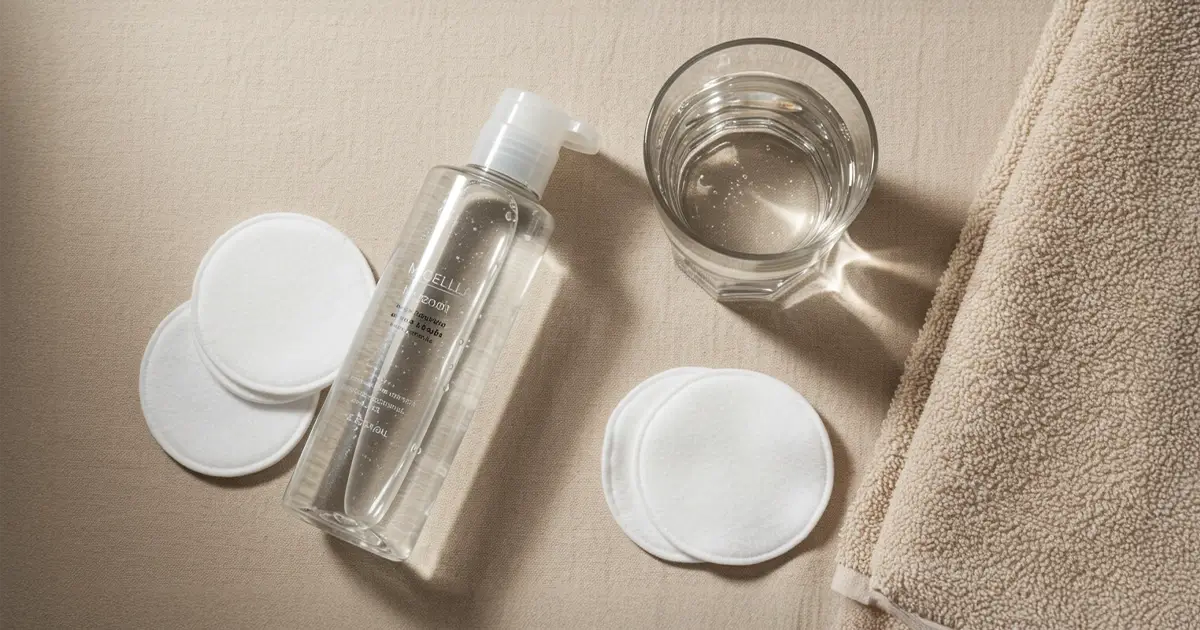Micellar water practically became the tote-bag cleanser of the last decade, popping up in every drugstore aisle and backstage makeup kit. In the next ten minutes I will unpack how those microscopic spheres whisk away grime, whether you truly can toss the towel and skip the sink, and which skin personalities should still reach for running water.
What Exactly Is Micellar Water?
If you could shrink yourself, Fantastic-Voyage style, and dive into a bottle of micellar water, you would spot clusters of surfactant molecules arranging themselves into soft, invisible spheres called micelles. Their oil-loving tails snuggle inward, trapping mascara, sunscreen, and city soot, while their water-loving heads reach outward so the fluid feels like plain water on your fingertips. When a cotton pad glides across your cheek, these micelles act like tiny Pac-Men, chomping through grease without the harsh lather of sulfates. Because the surfactant concentration remains low, the liquid keeps a watery texture, yet the cleaning power is surprisingly high.
The concept sounds modern, but it first took shape in French pharmacies during the early 1990s. Dermatologists wanted a leave-on option for patients irritated by Paris' famously hard tap water loaded with minerals. Makeup artists, perpetually short on time and sinks, adopted the bottles because one swipe could erase a smoky eye without leaving raccoon circles. Social media later handed micellar water a passport, and now you can buy a litre bottle for less than a latte or splurge on lab-tested elixirs that promise barrier support.
However, formulas vary wildly. Some brands add humectants like glycerin, soothing agents like panthenol, or antioxidants such as green-tea polyphenols. Others cut corners with drying alcohols or fragrance that can bother reactive skin. Always flip the bottle and read the ingredient list, especially if your cheeks flush at spicy food commercials. Remember: gentle marketing copy is not the same as a gentle surfactant profile.
Traditional foaming cleansers rely on linear surfactants that line up like soldiers, producing a dense lather that lifts oils but can tug away intercellular lipids. Micellar formulas usually employ non-ionic or amphoteric surfactants that gather into spheres rather than sheets. Because the surface area that touches skin is smaller, interaction with proteins is gentler, resulting in fewer complaints of tightness or stinging. This structural tweak is why dermatologists often recommend micellar water during periods of barrier repair, such as after a peel or during isotretinoin therapy.
Do You Need to Rinse? Breaking Down the Argument
Dermatologists argue about rinsing because data sit on both sides of the fence. Supporters of the no-rinse camp highlight trials showing low irritation scores when micellar formulations remain on skin for several hours under occlusion patches. Critics respond that many studies last only a week and focus on redness, not long-term barrier fitness. Translation: short visits are fine, permanent sleepovers may overstay their welcome.
Leaving leftover surfactants can nudge skin pH toward neutral, slowing the enzymes that glue corneocytes together and raising flakiness over time. In this study of thirty commercial micellar waters, half the samples measured above pH 6, a threshold many dermatologists call borderline for a healthy mantle. The authors concluded that occasional residue is safe, but recommended rinsing for eczema or rosacea sufferers. They also noted that cotton pads removed only about 80 percent of the formula, so a quick splash cuts exposure significantly.
Practical experience pushes me to a middle ground. On a late night when washing feels like a marathon, two soaked pads followed by moisturizer get the job done and keep mascara off my pillow. On sunscreen-and-sweat summer days, adding a thirty-second rinse makes breakouts less likely. I treat micellar water like dry shampoo: wonderful for emergencies, yet not a substitute for a proper wash. Your skin is not a T-shirt you can Febreze indefinitely.
One point often ignored in the debate is regional water hardness. Calcium and magnesium ions in hard tap water can react with soap-based cleansers to create residue that feels squeaky, but micellar water sidesteps that chemistry. Yet those same ions may remain on the face if you skip rinsing, potentially interacting with leave-on acids or peptides applied later. A brief rinse with filtered or distilled water, or even a facial mist, helps minimize unknown reactions.
Skin Types, Formulations, and Real-World Scenarios
Skin personality plays a huge role in whether you rinse. Sensitive or barrier-challenged faces should choose fragrance-free bottles and still consider a rinse, because even mild surfactants can accumulate after multiple layers of skin care. If you already patch test new serums, patch test micellar water too, because surfactant blends differ as much as coffee roasts.
Oily or acne-prone friends often love the airy feel of micellar water, yet sebum dissolves best when surfactant concentration is higher. That means more residue. I suggest wiping, then doing a sixty-second rinse, especially if you layer foundation, powder, and SPF. Over washing can rebound with greasy shine, so balance is key. For deeper thoughts on the perils of over-cleansing you might enjoy my piece Daily Scrubbing for Clean Skin that breaks the myth of the squeaky finish.
Dry or mature skin often wakes up feeling parched. Leaving micellar water on in the morning removes sleep sweat without stripping lipids, but still layer a hydrating mist or essence afterward because micelles themselves do not deliver large doses of humectants. A friend once replaced her entire routine with micellar water alone and soon wondered why her cheeks felt like parchment. Clearing dust is not the same as feeding thirsty skin.
Common Mistakes and How to Fix Them
Common mistake number one: saturating a single pad, swiping once across the face, then calling it a night. By the time that pad hits your forehead it is already full of foundation and redistributes grime. Use fresh cotton for each quadrant or, better yet, grab reusable microfiber rounds and keep a little laundry bag nearby.
Mistake two is expecting gentle micellar water to melt waterproof mascara designed to survive a Nicholas Sparks movie. Loosen stubborn eye makeup with a biphasic remover first, then finish with micellar water. Your lashes will thank you by staying attached, and panda eyes will stay in zoos where they belong.
Mistake three: skipping moisturizer because the skin feels soft already. Micelles lift away sebum and sweat but leave the surface slightly vulnerable. Seal the deal with a serum or lightweight lotion within two minutes. Future you will look back from the mirror and applaud.
How I Incorporate Micellar Water in My Routine
Morning travel days are prime micellar moments. Hotel pipes can rage and cough rusty water, so I soak two reusable pads before I even unzip my wash bag. A gentle wipe over face and neck refreshes me before the airport buffet, and nobody suspects I skipped the questionable sink. Several flights later, my skin still feels calm instead of tight.
On filming days I wear long-wear foundation that could survive a monsoon. I begin the night with micellar water to break the color layer, rinse, follow with a low-foam gel, and finish with a ceramide cream. The double step reduces friction, and I lose fewer eyelashes to aggressive towels. My cat once stared at the used cotton pads with horror, which proves even pets judge leftover makeup.
I also keep a mini bottle in my gym bag. A quick swipe after spinning removes salty sweat before it can marinate until I reach the shower. That micro-habit cut my post-workout breakouts in half, which is as satisfying as closing all my exercise rings by noon.
Sustainability and Micellar Water
Every swipe has a footprint, and the cotton pad mountain in my bathroom bin once shocked me into action. Conventional cotton farming demands pesticides and considerable water, while single-use discs often come wrapped in plastic. Switching to reusable bamboo or microfiber rounds cuts both waste and long-term cost. They feel like tiny towels, wash well at sixty degrees, and lose only minimal softness over a year of weekly cycles.
The bottle itself matters too. Clear PET can usually join curb-side recycling, but pumps and flip caps may need separating. Look for brands that use post-consumer resin or offer refill pouches to shrink your carbon shadow. Some companies now sell solid micellar bars that lather with very little water, though the technology is new and the surfactant profile still under review by chemists.
Finally, ingredients flow down the drain in rinse scenarios, so opt for readily biodegradable surfactants such as polyglyceryl-4 caprate. Label reading is homework, yet the payoff is cleaner skin and a cleaner conscience. I like to think of sustainability as skin care for the planet: we protect its barrier today so future generations stay healthy tomorrow.
A quick numbers aside: switching from five disposable cotton rounds per day to two reusable ones saves roughly three thousand pads a year. Stack them, and you would match the height of a snowy mountain shaped like a guilt iceberg in your mind. That cheerful statistic usually convinces even my most eco-reluctant friend to pop a washable round into her shopping cart.
FAQ
Can micellar water replace face wash permanently?
Not for most people. It is brilliant for travel or lazy nights, yet a balanced routine still needs a rinse-off cleanser a few times a week to prevent buildup and maintain pH.
Is micellar water safe around the eyes?
Yes, when the formula is ophthalmologist tested, but remove waterproof mascara with an oil phase first to avoid excessive rubbing.
Will micellar water clog pores?
The liquid itself is non-comedogenic, yet leftover makeup can block follicles. Rinsing or double cleansing solves that problem.
Can I use micellar water after retinoids?
Absolutely. Many dermatologists prefer it over harsh foams on retinoid nights because it lowers irritation risk while still removing residue.
Does micellar water expire?
Opened bottles usually last six months. An off smell or cloudy appearance means it is time to recycle and open a fresh one.
Can men use micellar water on beards?
Definitely. Saturate a pad, swipe along the hair growth, then pat dry or rinse. It lifts sweat without leaving beard hair brittle.
Do dermatologists agree on micellar water for infant skin?
Opinions vary. Most agree that occasional use on baby cheeks while traveling is acceptable, but daily cleansing should rely on lukewarm water and fragrance-free baby wash to preserve the especially delicate acid mantle.
Does rinsing micellar water cancel its leave-on moisturizing effect?
Not really. Most hydration comes from the follow-up serum or cream. A quick rinse removes excess surfactant without stripping glycerin or panthenol already absorbed during the wipe.
Conclusion
Micellar water is a clever hybrid that rescues us on planes, in dorm bathrooms, and during power outages. Rinse when heavy grime, mineral sunscreen, or multiple makeup layers are involved, skip the sink when you truly must, and always listen to your own skin's feedback rather than blanket rules.
See you in the next post - until then, take good care of your skin! Our little corner of the internet keeps glowing when we share honest experiences, so drop yours below.


Comments (0)
No comments yet - be the first to share your thoughts!
Leave a Reply
Your email address will not be published. Required fields are marked *